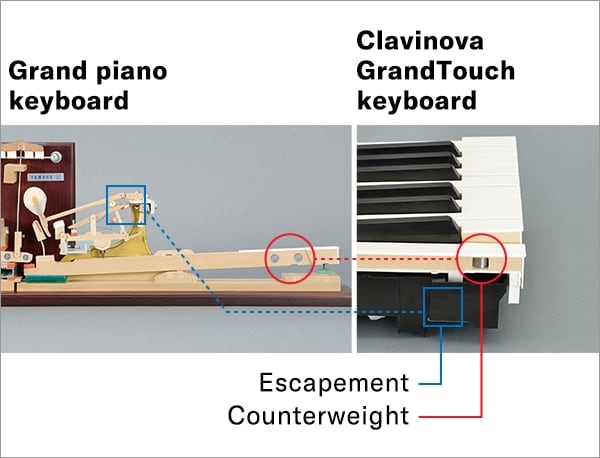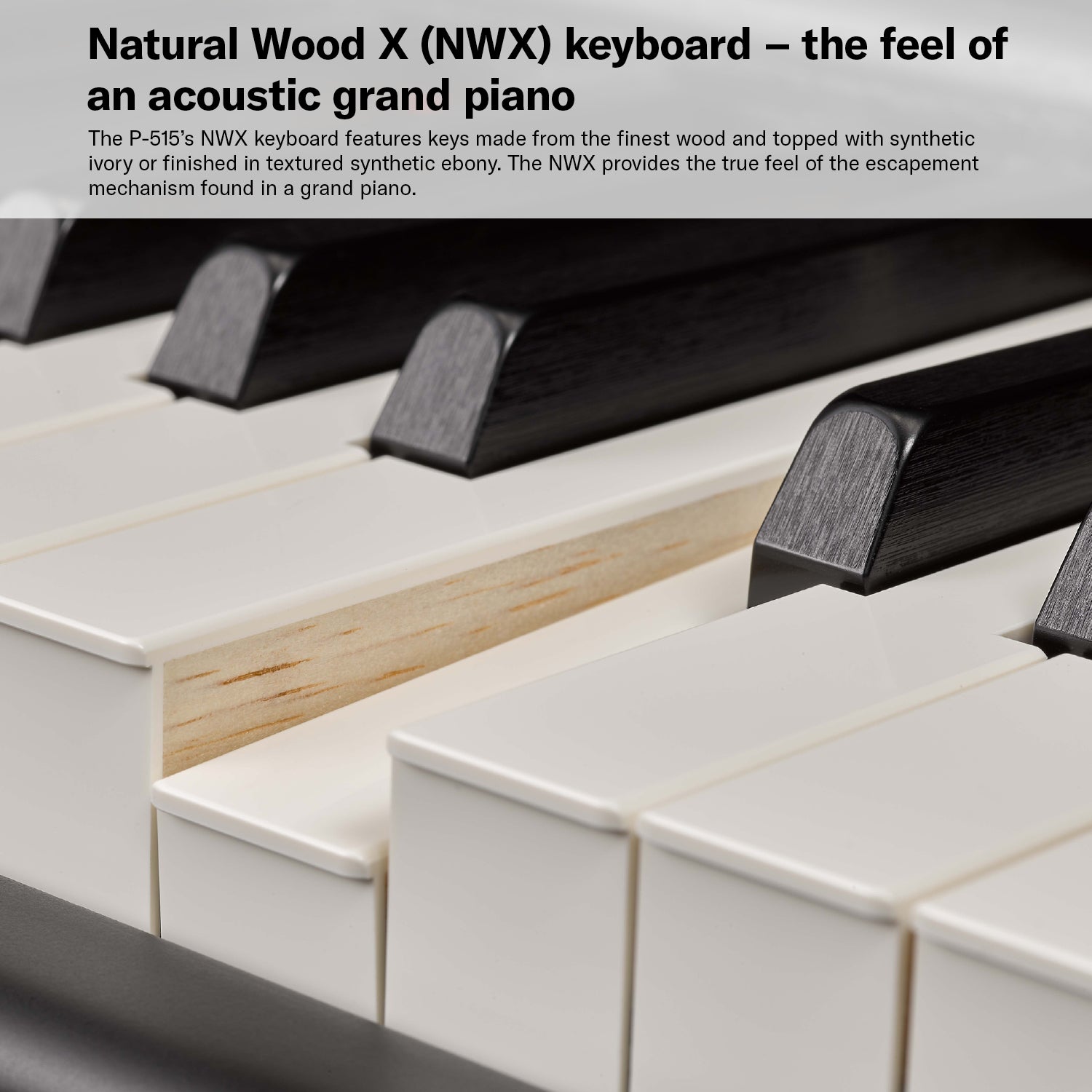Escapement on a digital piano replicates the mechanical touch response of an acoustic piano. This feature ensures a more authentic playing experience.
If you’re considering purchasing a digital piano or seeking to understand your instrument better, the concept of escapement is integral to the digital piano’s design. Escapement, also known as let-off, is the mechanism by which acoustic pianos create a slight resistance when a key is pressed halfway, giving pianists a nuanced control over their playing dynamics.
Digital pianos, striving to mimic the subtlety of this action, employ sophisticated technology to offer the same tactile feedback found in their traditional counterparts. Recognizing this can deepen your appreciation for your instrument’s craftsmanship, and enhance your expressivity during performance. Whether you’re a budding musician or a seasoned pro, understanding how escapement on your digital piano works can elevate your playing technique.

Credit: asia-latinamerica-mea.yamaha.com
The Role Of Escapement In Digital Pianos
The Role of Escapement in Digital Pianos refers to a feature that mimics the mechanical action of an acoustic piano. It’s what connects your touch to the music. Let’s explore why it’s essential for the authenticity of digital pianos.
Linking Feel To Sound Production
Escapement gives the feeling of a real piano. When you press a key on a traditional piano, escapement lets the hammer move back slightly. This makes the key feel lighter. Digital pianos use this feature to recreate that feel. Even though they use sound samples, escapement helps players express themselves more fully.
Differences From Acoustic Pianos
In acoustic pianos, escapement is a physical process involving complex machinery inside the piano. But digital pianos simulate this using advanced technology. They do not have hammers but use sensors and software to reproduce the feel of an escapement. This lets pianists transition from acoustic to digital without losing the touch they love.

Credit: hub.yamaha.com
Mechanics Behind Escapement Simulation
The ‘Mechanics Behind Escapement Simulation’ explores how digital pianos reproduce the tactile feedback of an acoustic piano’s escapement. This intricate process is fundamental for pianists seeking an authentic playing experience on digital instruments. We delve into the traditional mechanics and then explain how digital pianos mimic this effect.
Traditional Escapement Mechanics
The escapement on a piano plays a crucial role. It allows the hammer to fall away from the strings. This lets the string vibrate freely after being struck. Here’s how it works:
- Pressing a key starts the motion.
- A series of levers swings into action.
- The hammer head strikes the string.
- The escapement mechanism releases the hammer before it bounces.
In an acoustic piano, the ‘let-off’ provides tactile feedback. This lets the player control dynamics and articulation smoothly.
Digital Simulation Techniques
Digital pianos don’t have strings or hammers. They use advanced technology to simulate the escapement feel. Below are the techniques they use:
- Sensors and weighted keys mimic the mechanical resistance.
- Different sound samples activate according to touch strength.
- Software algorithms adjust the timing of sound samples.
- Haptic feedback systems give a physical sensation of let-off.
Manufacturers craft each key to feel like you’re pressing an acoustic piano key. The goal is to ensure a seamless transition for pianists between instruments.
Impact On Performance And Playability
An escapement mechanism in a digital piano profoundly influences a musician’s experience. The presence of this feature replicates the feel of an acoustic piano, where a slight resistance is felt when a key is pressed, commonly known as the ‘click’ feeling. This subtle effect can make all the difference in performance and playability for beginners and professionals.
The Importance Of Touch Sensitivity
Touch sensitivity refers to how a digital piano responds to the force of your touch. Pianos with high touch sensitivity allow for expressive playing. You get soft sounds with gentle presses and louder tones with harder presses, just like an acoustic piano. This gives pianists the nuance and dynamic range needed for expressive performances.
- Vital for dynamics control
- Creates an emotional impact
- Improves technique development
Comparing Responsiveness And Control
Responsiveness and control are the heartbeats of piano performance. They empower musicians to convey precise emotions. With advanced escapement features, digital pianos offer that control. Below is a quick comparison:
| Responsiveness | Control | |
|---|---|---|
| Without Escapement | Limited dynamic range | Difficult to play expressively |
| With Escapement | Wide dynamic range | Precise expression achievable |
Pianists can thus deliver every nuance of emotion through their music with the right escapement on a digital piano.
Technological Advances In Escapement Features
The escapement mechanism in acoustic pianos gives pianists a sense of tactile feedback. This tactile feedback creates a realistic touch. Digital pianos strive to replicate this sensation. Technological strides have made this more achievable.
From Weighted Keys To Smart Sensors
Digital improvements bridge the gap between traditional and modern pianos. Consider the evolution of digital piano keys:
- Weighted keys provide a heft resembling acoustic pianos.
- Graded action varies the weight from low to high notes.
- Hammer action simulates the hammers striking strings.
Today’s digital pianos take a leap forward using smart sensors. These sensors detect nuanced playing. They deliver detailed feedback. This feedback mirrors an acoustic piano’s escapement.
Future Developments And Innovations
Manufacturers continue to innovate. Breakthroughs in technology hint at what’s next:
| Technology | Potential Impact |
|---|---|
| AI Integration | Artificial intelligence could adapt to a player’s style. It could provide a tailored playing experience. |
| Haptic Feedback | Improved haptic systems may bring closer mimicry. They could rival the feel of grand piano escapements. |
| Touchscreen Interfaces | Customizable touchscreens could replace physical buttons. They could offer greater control over the escapement illusion. |
Advancements in escapement features promise exciting times. They aim to bring the nuance of acoustic performance to digital platforms.
Choosing A Digital Piano With Escapement
When passion for music and the hunt for authenticity merge, escapement becomes a pivotal feature in digital pianos. Escapement, or let-off, replicates the tactile feedback of an acoustic piano’s hammer action. It’s essential for those wishing to closely mimic the touch of a grand piano. This guide helps in selecting a digital piano equipped with escapement for an immersive playing experience.
What To Look For In Key Action
Realism and Responsiveness stand tall on your digital piano checklist. Here’s how to ensure the keys meet your hands with familiarity:
- Weighted keys: They should feel heavy, just like an acoustic piano’s.
- Graded action: Lower notes feel heavier, while higher notes are lighter.
- Touch sensitivity: Subtle dynamics are possible with varying touch.
- Escapement simulation: A slight notch sensation as you press the keys softly.
Must-have Features For Serious Pianists
Serious pianists need serious tools. Aim for these features to elevate your playing:
| Feature | Why It’s Important |
|---|---|
| Polyphony | More notes played simultaneously without dropout. |
| High-Quality Samples | Crisp, vibrant sounds that fill the room. |
| Recording Capability | Track your progress and compose with ease. |
| Connectivity | Link to apps or external devices for expanded use. |
Escapement’s Place In Digital Piano Education
The concept of escapement might seem abstract in the realm of digital pianos. Yet, it holds substantial value in learning and playing these instruments. Escapement refers to the mechanism in acoustic pianos that causes the hammers to fall back slightly after they hit the strings. This allows for delicate note repetition and nuanced playing dynamics. Digital pianos replicate this tactile feedback to provide a more authentic playing experience. This feature is particularly beneficial for students mastering piano techniques, as it bridges the gap between digital and acoustic play.
Improving Technique With Realistic Key Response
Fostering the proper technique is crucial in digital piano education. Escapement offers a realistic key response, teaching students the delicate touch required for acoustic pianos. This key feature:
- Enhances muscle memory through repetition and feedback.
- Allows for subtle dynamics and expression in playing.
- Encourages a gentle key touch, preventing harsh keystrokes.
Realistic key response emulates the tactile sensation felt during an acoustic performance. Practice on such keyboards ensures seamless transitions to traditional pianos for recitals or exams.
Educational Tools And Programs Incorporating Escapement
Many educational tools and software have embraced escapement technology. Programs designed for digital piano learning often include:
- Interactive lessons that highlight the importance of key response.
- Visual aids to demonstrate proper finger placement and movement.
- Quizzes and games that focus on dynamic control, made possible by escapement features.
Such tools assist beginners in understanding and feeling the difference escapement makes. As they progress, this feature becomes integral to their musical development and precision in playing.

Credit: handhmusic.net
Can Escapement Feature be Found in Hybrid Digital Pianos?
Yes, an escapement feature can be found in hybrid digital pianos. The escapement is a mechanical element that simulates the feeling of a traditional piano action. This feature enhances the playing experience by replicating the tactile response of a real piano. So, what is a hybrid piano? It’s a digital piano with a mix of acoustic and electronic elements.
How Does Escapement Function Differ in a Digital Piano Compared to a Digital Grand Piano?
Understanding the digital grand piano concept is essential for musicians transitioning from traditional instruments. In a digital piano, escapement mechanisms are simplified, offering a consistent touch. In contrast, digital grand pianos mimic the intricate escapement of acoustic models, providing a more authentic playing experience and nuanced dynamics for advanced players.
Frequently Asked Questions For What Is Escapement On A Digital Piano
Is Escapement Important On A Digital Piano?
Yes, escapement on a digital piano is important. It mimics the feel of an acoustic piano, providing a more realistic touch response and playing experience. This feature enhances expressiveness and nuance when playing.
What Does The Escapement Do For A Piano Action?
The escapement in a piano action allows the hammer to fall back slightly after striking a string, preventing it from blocking the string’s vibrations and enabling quick repeated notes.
What Is The Escapement Feature?
The escapement regulates a clock’s energy release, ensuring precise timekeeping through controlled gear movements. It transforms rotational energy into an oscillating motion, crucial for accurate time measurement.
Do Upright Pianos Have Escapement?
Most upright pianos feature an escapement mechanism, similarly found in grand pianos, although the design may vary slightly.
Conclusion
Escapement on a digital piano enriches the playing experience, mirroring the tactile feedback of acoustic pianos. This feature is key for nuanced expression and dynamic control. By understanding and utilizing escapement, musicians can unlock a more authentic performance. As technology advances, digital piano realism continues to grow, enhancing practice and enjoyment for pianists at every level.
